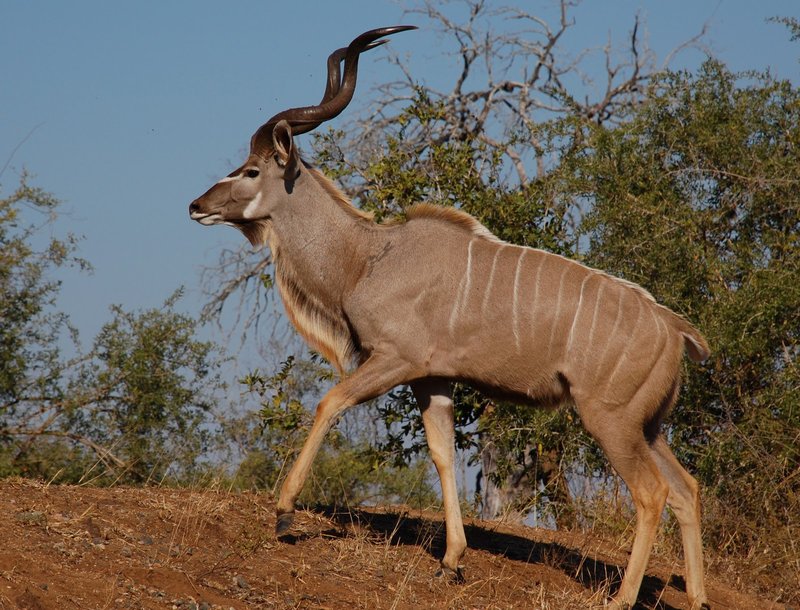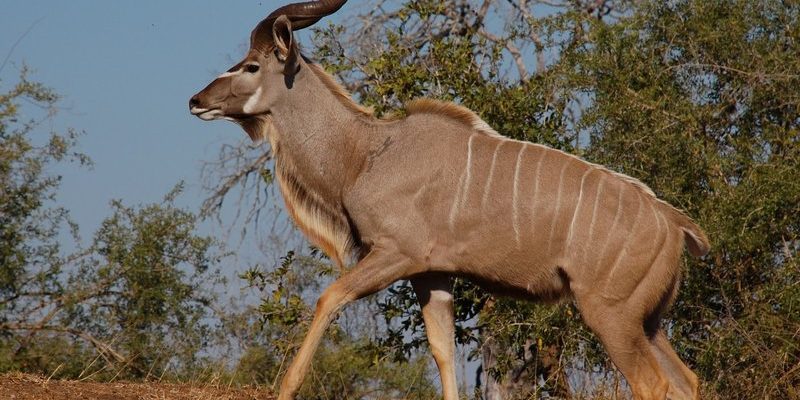
In this article, we’ll take a closer look at ten animals that resemble the kudu. We’ll break down how to tell them apart, focusing on their distinctive traits, habitats, and behaviors. Whether you’re a wildlife enthusiast or just curious, you’ll learn some neat facts that might surprise you!
1. Greater Kudu
Let’s kick things off with the greater kudu, which is essentially a cousin to the one you’re familiar with. Found in eastern and southern Africa, this tender-hearted antelope can weigh between 400 and 600 pounds. One of the most notable features of the greater kudu is its impressive spiral horns, which can reach lengths of up to 6 feet!
In terms of appearance, their coats are a mix of gray and brown, with white stripes running down their sides. These stripes not only make them look stunning but also serve as camouflage in the dappled light of the forest. If you ever spot a kudu in the wild, look for their gentle, large eyes—they really do give them a sweet demeanor!
2. Nyala
Next up is the nyala, another antelope that might catch your eye. Nyala are generally smaller than kudus but are equally beautiful, especially the males, who sport long, curved horns and striking shaggy coats. You’ll often find them grazing in dense bush areas or woodland, making them a bit trickier to spot.
The biggest giveaway that you’re looking at a nyala rather than a kudu is the male’s distinctive coloration. Males have dark brown coats with white facial markings and stripes, while females are reddish-brown with similar markings. These differences in color can help you tell the two apart at a glance, especially if you’re on a safari!
3. Impala
Now let’s talk about the impala. These agile antelopes are known for their incredible speed and grace. They are smaller than kudus and have a more slender build. Impalas are often found in open grasslands, where they can easily outrun predators.
While kudus have those majestic spiraled horns, impalas have shorter, straight horns, which also twist slightly. If you ever see a group of impalas jumping and bounding through the grass, you’ll quickly understand why they’re often referred to as one of Africa’s most beautiful animals.
4. Bushbuck
The bushbuck is another animal that shares a habitat with kudus but has its own flair. They are compact, with a stocky body, and can range from reddish-brown to dark brown, often adorned with white markings on their face, throat, and legs. Unlike the kudu’s long horns, bushbucks have shorter, straighter horns.
What’s interesting about bushbucks is their adaptability; they thrive in various habitats, from dense forests to open woodlands. If you’re looking for a bushbuck, check for them sneaking through underbrush or near water sources, where they often go to drink.
5. Sitatunga
If you venture near swamps and marshy areas, keep an eye out for the sitatunga. These amazing antelopes are semi-aquatic and have long, splayed hooves that help them navigate muddy waters. Sitatungas are unique among antelopes for their ability to swim well, and they often submerge themselves to avoid predators.
In terms of appearance, both male and female sitatungas have a similar body shape to kudus, but males have long, twisted horns like those of the greater kudu. Females are typically lighter in color and may have fewer markings. If you see one, note how they blend into their watery environment!
6. Bongo
The bongo is another striking animal that closely resembles a kudu but adds a twist with its vibrant coloring. These large forest antelopes are known for their reddish-brown coats and white stripes, which make them stand out in the underbrush. They also have long, spiraled horns similar to kudus, which can be quite impressive.
Bongos are usually shy and prefer dense forest habitats, making them hard to spot. If you find yourself in their territory, listen for rustling leaves as they navigate through their habitat. Unlike kudus, bongos are more elusive, which only adds to their charm.
7. Roan Antelope
The roan antelope is another majestic animal that might remind you of a kudu, but with a more robust build. They tend to have a more brownish-gray coat with a distinctive reddish hue on their faces and behind. Roan antelopes are larger than kudus and have long, curved horns, giving them an imposing look.
What sets roan antelopes apart is their unique facial markings and the white tuft on their tail. These differences, combined with their larger size, make them relatively easy to distinguish from kudus, especially if you see them standing among the grasslands.
8. Topi
The topi is another type of antelope that shares a similar shape with the kudu but is much more colorful. They have a reddish-brown body with dark blue and black facial markings. Topis are known for their unique, sloping backs and can often be seen in large herds on the savanna.
One way to tell a topi apart from a kudu is by its distinctive coloration and the shape of its horns, which are shorter and more straight compared to a kudu’s. If you happen to spot one, watch for their lively behavior as they interact with each other—it’s often quite a spectacle!
9. Waterbuck
Last but not least, the waterbuck is an antelope that thrives near water sources. They’re easily recognized by their large size and the white circle on their rear, which helps alert other animals to danger. Waterbucks have long, straight horns that curve backward, making them different from a kudu’s spiral horns.
In terms of habitat, like their name suggests, waterbucks prefer grasslands and savannas near lakes or rivers, which can make them easier to see than kudus hiding in dense foliage. If you’re near water, keep an eye out for these magnificent creatures!
10. Gazelles
Finally, we can’t forget the gazelles, which come in various species and are known for their grace and speed. Although they are much smaller than kudus, their sleek bodies and agility give them a similar silhouette. Gazelles have long, thin horns that often take on a spiral shape.
With their lighter build and quick movements, gazelles usually inhabit open grasslands where they can easily spot predators. If you see a group of them bounding effortlessly across the plains, you’ll understand why they’re often dubbed “the dancers of the African savanna.”
Exploring the animal kingdom can feel a bit like piecing together a giant puzzle. Just like family members who share some traits but each have their unique stories, the animals similar to the kudu all have their special qualities that set them apart. Whether it’s their habitat, behavior, or distinctive markings, these antelopes and their relatives each add to the beautiful tapestry of wildlife.
Next time you come across a kudu or any of its relatives, take a moment to appreciate their unique traits. Understanding these differences not only enhances your wildlife watching experience but also deepens your appreciation for nature’s incredible diversity. So, grab your binoculars and head out—there’s a whole world of wonders waiting for you to discover!

